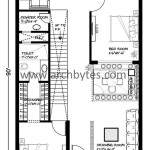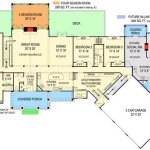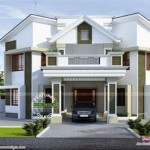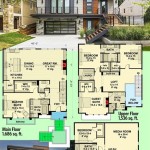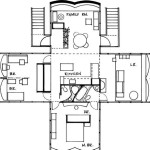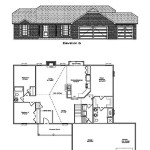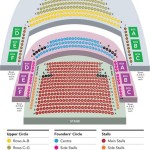House Plans Featuring Front Kitchens and Back Living Rooms
The concept of a house plan featuring a front kitchen and a back living room, or family room, represents a specific architectural approach to residential design. This configuration, while not universally implemented, offers a distinct set of advantages and disadvantages that influence factors such as natural light distribution, privacy, and the overall flow of the home. Understanding these nuances is essential for prospective homeowners and builders seeking to optimize their space based on their specific lifestyle and programmatic needs. This article delves into the various aspects of this house plan arrangement, exploring its key benefits, potential drawbacks, and common design considerations.
The layout, fundamentally, positions the kitchen at the front of the house, often near the entry point or street-facing façade. The primary living area, conversely, is situated at the rear of the property, typically overlooking the backyard or garden. This arrangement contrasts with more traditional home designs where the living room occupies the front and the kitchen is relegated to the back or center of the house. The deliberate placement of these functional spaces creates a specific dynamic between public and private areas within the dwelling.
Maximizing Natural Light and Views in the Living Room
One of the primary rationales behind placing the living room at the back of the house is to maximize the utilization of natural light and views. Backyards are generally more private and often offer larger windows or sliding glass doors, allowing for increased sunlight penetration and panoramic vistas. This arrangement is particularly advantageous in climates where natural light is limited or where appealing landscaping significantly enhances the living experience. The living room, therefore, becomes a bright and inviting space that fosters relaxation and connection with the outdoors.
Furthermore, the orientation of the living room towards the backyard provides a natural extension of the living space, particularly when incorporating outdoor features like patios, decks, or gardens. The seamless transition between indoor and outdoor environments promotes a sense of spaciousness and encourages outdoor activities. This design strategy is particularly effective in warmer climates or environments where outdoor living is a significant part of the lifestyle. Considerations should be given to window placement and size to control heat gain and glare, and to maintain privacy from neighboring properties.
The rear placement also offers an opportunity to create a dedicated entertainment space separate from the more functional aspects of the kitchen. By dedicating the back of the house to living and recreational activities, the design promotes a relaxed and informal atmosphere, suitable for family gatherings or social events. Proper insulation and soundproofing can further enhance the enjoyment of this space, particularly if the kitchen is prone to noise during meal preparation.
Strategic Kitchen Placement and Functionality
Placing the kitchen at the front of the house presents a unique set of design challenges and opportunities. While it might deviate from conventional norms, it can be a strategically sound decision depending on the specific requirements of the homeowner and the overall architectural style. One significant advantage is the potential for enhanced curb appeal.
A well-designed front kitchen can become a focal point of the home's exterior, particularly if it incorporates large windows or strategically placed lighting. This can create a welcoming and visually appealing façade. It also offers the advantage of easy access for grocery unloading and deliveries, minimizing the distance to transport items from the vehicle to the storage areas. This is especially beneficial for individuals with mobility limitations or those who frequently purchase large quantities of groceries.
However, placing the kitchen at the front requires careful consideration of privacy and street noise. Strategies such as incorporating landscaping, using frosted glass, or installing soundproof windows can mitigate these concerns. The design should also prioritize efficient and organized layout to avoid creating a cluttered or unappealing view from the street. The use of high-end appliances and attractive cabinetry can further enhance the visual appeal of the front kitchen.
The kitchen’s proximity to the front door also offers opportunities for interaction with visitors. The kitchen can become a natural gathering space for informal conversations and quick visits, fostering a sense of community and connection. However, it's essential to balance this openness with the need for privacy and functional space for meal preparation. A well-defined entryway or a separate mudroom can help to create a buffer zone between the kitchen and the main entrance.
Design Considerations and Interior Flow
The overall success of a house plan with a front kitchen and back living room hinges on the seamless integration of these spaces and the creation of a cohesive interior flow. The transition between the kitchen and the living room should be smooth and intuitive, avoiding awkward or confined passageways. This often involves incorporating an open-concept design or a strategically placed hallway that connects the two areas.
The placement of the dining area becomes particularly important in this type of floor plan. The dining area can be integrated into either the kitchen or the living room, depending on the desired level of formality and the available space. If the dining area is located within the kitchen, it can create a more casual and convivial atmosphere. Conversely, if it's situated in the living room, it can provide a more formal and defined dining experience. The size and layout of the dining area should be carefully considered to accommodate the needs of the household and to ensure comfortable circulation.
Furthermore, the location of other essential rooms, such as bedrooms and bathrooms, should be carefully planned to ensure privacy and functionality. Bedrooms are typically located away from the main living areas to provide a quiet and restful environment. Bathrooms should be conveniently accessible from both the bedrooms and the main living areas. The flow of traffic within the house should be carefully considered to avoid creating bottlenecks or disrupting activities in different areas.
Lighting design plays a crucial role in enhancing the overall ambiance and functionality of the front kitchen, back living room arrangement. Natural light should be maximized in both areas, with consideration given to window placement and shading devices. Artificial lighting should be carefully selected to provide adequate illumination for various tasks and activities, while also creating a warm and inviting atmosphere. Layered lighting, including ambient, task, and accent lighting, can be used to create a dynamic and visually appealing environment.
Material selection is another key consideration. The materials used in the kitchen and living room should be cohesive and complement the overall architectural style of the house. Durable and easy-to-clean materials are particularly important in the kitchen, while comfortable and aesthetically pleasing materials are essential in the living room. The use of contrasting textures and colors can add visual interest and create a sense of depth and dimension.
Ultimately, a house plan featuring a front kitchen and a back living room requires a thoughtful and deliberate design process that considers the specific needs and preferences of the homeowner. By carefully considering the advantages and disadvantages of this arrangement and by paying close attention to design details such as natural light, privacy, interior flow, and material selection, it is possible to create a functional, aesthetically pleasing, and truly livable home.
Space planning concepts are crucial for optimizing usability. Storage solutions should be integrated throughout the house, maximizing the use of vertical space and creating designated areas for different items. This will help to maintain a clutter-free and organized environment. The selection of furniture and accessories should also be carefully considered to ensure that they complement the overall design and provide comfortable and functional living spaces.
Energy efficiency is another important factor to consider when designing a house with a front kitchen and back living room. Proper insulation, energy-efficient windows and appliances, and smart home technology can help to reduce energy consumption and lower utility bills. The orientation of the house should also be considered to maximize solar gain in the winter and minimize heat gain in the summer. This can help to create a more comfortable and sustainable living environment.

Contemporary Home Plans With Great Kitchens Houseplans Blog Com

Small House Plans With Pictures Houseplans Blog Com

Modern House Plans With A View To The Rear Blog Dreamhomesource Com

Economical Contemporary Modern House Plan With Open Floor Layout 7819

Contemporary Home Plans With Great Kitchens Houseplans Blog Com

Modern House Plans With A View To The Rear Blog Dreamhomesource Com

L Shaped House Plans With 3 Bedrooms Houseplans Blog Com

Beautiful Small Country House Plans With Porches Houseplans Blog Com

Hatchet Creek Cabin Small Guest House Plan

Exciting House News A Change In Floor Plans Addicted 2 Decorating

